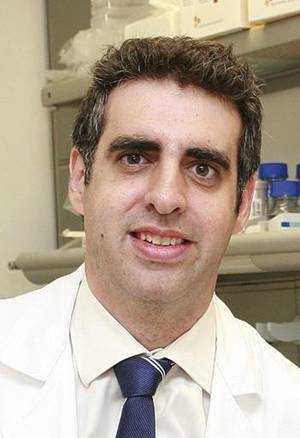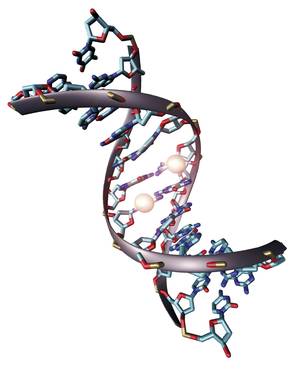DNA is not ALL
"If genes are words of our composition, epigenetics would be signs that make these sequences of words understandable: spelling and grammar. This means that the same gene variety can give two people a different external aspect." This explanation was given by researcher Manel Esteller. Esteller is a researcher at the Bellvitg Biomedical Research Institute, specifically director of the epigenetics and cancer biology program.
By definition, epigenetic factors are those that, without altering the sequence of DNA, cause the appearance of variants in the phenotype, since they influence the expression of the genes. Among its influences are liver and heart cells with a different appearance and function, as well as the characteristics that characterize twins. "Monocygothic twins show how genetically equal individuals can have different characteristics. They are, therefore, exceptional models to analyze the influence or role of epigenetic changes in phenotype," explains Esteller.
Esteller considers epigenetic factors as important as genes themselves. Genes and genetics in general are much better known than epigenetics. "There are several reasons for this - believes Estellerrek--. The main thing is that genetics studies began much earlier; the first were performed by Mendel in the XIX. At the end of the twentieth century. Modern epigenetics was born in the 1980s. There were suspicions that the medium was somehow talking to genes and people with the same genes were seen to have different behaviors and diseases. But there was no biological explanation. Epigenetics has given the biological explanation."
Marks that are inserted into the DNA and its environment
Influencing the expression of genes is expressing some genes and silencing others. To do this, it is not necessary to modify the sequence of DNA, that is, to perform mutations. Just place in the sequence itself or close to it marks that drive or interrupt the expression. Two are the main epigenetic mechanisms: methylation and histone acetylation.
Methylation occurs directly in the DNA sequence, adding a group of methyl to the cytosine base. In general, methylation occurs in regions with numerous cytosines, with a guanine base, which are found in the gene promoter region. "Methylation is like a switch: when it binds to cytosine it turns off the expression of that gene," explains Esteller.
Histone acetylation, on the other hand, implies the expression of genes that by themselves should be silenced. This change, as its own name indicates, occurs in histones. Histones are a series of proteins that help to package DNA. In fact, DNA has a length of two meters and must be very compacted to enter the cell nucleus. In this packaging, the DNA filament is wound around the histones (they resemble a pearl necklace). The filament can be associated more or less with histones, depending on the degree of acetylation of histones: if groups of acetylene are joined in histones, the DNA develops quieter.

The degree of DNA packaging is related to the degree of expression of their genes: the more compact the gene is, the more difficult the expression of the genes is, since the transcription elements cannot be associated with the DNA sequence. On the contrary, if it is quieter, it can associate transcription activators and produce the transcription of the genes.
Essential and variable
Gene activations and deactivations due to methylation and histone acetylation "are essential - according to Estell- to survive, without which we would die in the early stages of development. In addition to influencing cell differentiation, the inactivation of one of the X chromosomes in women is something that is done through epigenetic mechanisms, for example." In fact, women have two copies of the genes of chromosome X and men one. Well, for individuals of both sexes, the doses of the products of these genes are the same, one of the two chromosomes is inactive in women.
Each living has a concrete epigenetic pattern. "As a species we have a pattern that allows us to be the Homo sapiens", said Esteller. And this pattern is changing with age: "At birth we have an epigenome, another in adolescence and another in maturity and old age," says the researcher.
Not only humans, but many animals have seen these epigenetic changes that accompany development. Let's think of a butterfly. This butterfly has a genome from birth, but its appearance is completely different before and after metamorphosis. "This is because the epigenetic pattern evolves - says Estellerrek--. The same can be seen, for example, in bees: The queen bee and the workers have the same genome; the epigenetic pattern of each of them makes the appearance and behavior of one and the other so different."
When the cells are folded they are bent with epigenetic patterns. In this way, they acquire the appearance of the other cells of this tissue. However, in the dubbing process punctual changes occur and the following cells do not have exactly the epigenetic pattern of the "anchor" cell. "This is very clear in the monocygothic twins," explains Esteller. In 2005 he published with his colleagues a study with twins in the magazine PNAS. There they said that the epigenetic pattern is increasingly different, the more aged in the twins.

The article explains that these changes may be due to both internal and external factors: "Small random errors can also occur in cell duplication, which causes two identical individuals in origin to differ over time. However, life habits and external factors such as smoking, physical activity, or diet can lead to long-term epigenetic changes. In the twins we have seen that more epigenetic differences had the older they were, they had more different life forms and spent less time together. This highlights the importance of environmental factors to give different phenotypes of the two equal genotypes".
As for external factors, "In general, we have seen that the same factors or agents that cause changes in genes may be responsible for epigenetic changes. That is, the factors that cause mutations in the genes can also cause methylations and acetylations of histones," said Esteller.
However, they are much more numerous and epigenetic changes are much faster than genetics. "It is more difficult for genetic changes to occur, since in millions of years of evolution we have learned to maintain genomic information and correct errors that occur," explains Estellerrek-. However, we are not so good correcting the epigenome. In fact, they do not have as much influence as genomes on survival and cells have not developed as many correction mechanisms."
Epigenetics associated with diseases
Changes in the epigenome can also cause disease. For example, cancer. This is one of the study topics of Manel Esteller at the Bellvitge Institute: "Cancer is the most known and precursor disease of epigenetics. This may be because it is a very frequent disease and it is easy to get samples for your study. In 1995 it was first discovered that an epigenetically modified gene could cause cancer."
For example, if genes that prevent excessive cell duplication (called tumor suppressors) are improperly methylated, these genes are silenced and do not function. Changes in histones are also related to the excessive proliferation of cells and, therefore, to cancer. On the other hand, the different epigenetic marks make two people who, by a certain genetic mutation, have the same predisposition to suffer cancer appear at different times, or appear in one and the other not.

Aside from cancer, "lately," says Estell--in the study of other diseases caused by epigenetics. For example, the most autoimmune diseases. In these diseases, the body produces antibodies against their proteins because epigenetic marks have not been correctly placed in the genes that synthesize them. In addition, epigenetic studies with neurodegenerative and cardiovascular diseases have recently been initiated."
As the relationship of epigenetic changes with diseases is clarified, the drugs to combat them appear. In fact, epigenetic changes can be reversible if a methylation or acetylation change is corrected externally. Esteller has pointed out that currently "there are five epigenetic drugs admitted for use in Europe to treat certain types of leukemia and lymphomas. These drugs inhibit the methylation of DNA and the deacetylation of histones."
In addition to medications, researchers have already begun to use epigenetic changes as disease indicators. "In some cases we have found that the methylation of a specific gene that should not be methylated indicates that the person has cancer, or that the methylation of a gene will have a good response to chemotherapy.
All these applications start from basic research. "In basic research we seek to discover what mechanisms cause changes and decipher all human epigenomic patterns." For this last objective is underway the project called Human Epigenoma, of which “we are members. The final objective is to determine the epigenome of each type of human cell. In fact, each person has a single genome, but the epigenomas, about 150. One for each type of cell".
Methyloma (methylation pattern) of certain cell types, such as lymphocytes, colon cells, and some stem cells, is already defined. "Therefore, the methyloma of other cells is still to be elucidated and the general pattern of histone change," explains Esteller.







